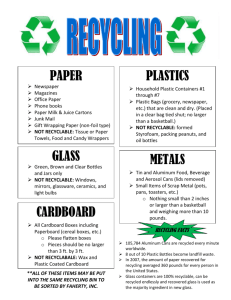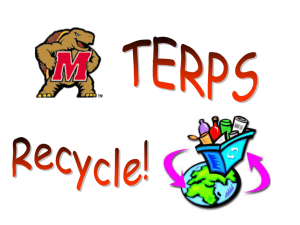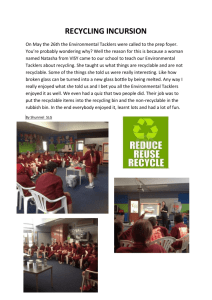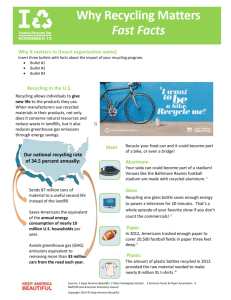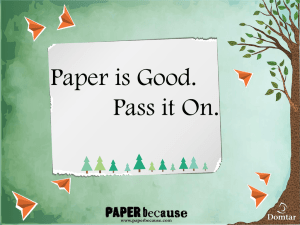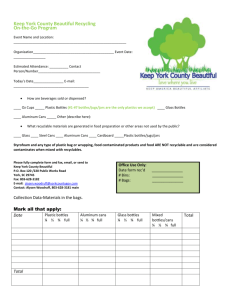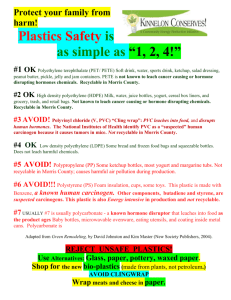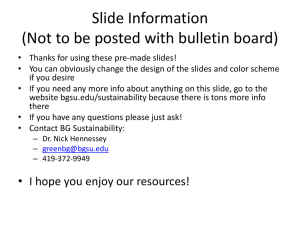Recycled Art Project Lesson Plan: Middle School
advertisement
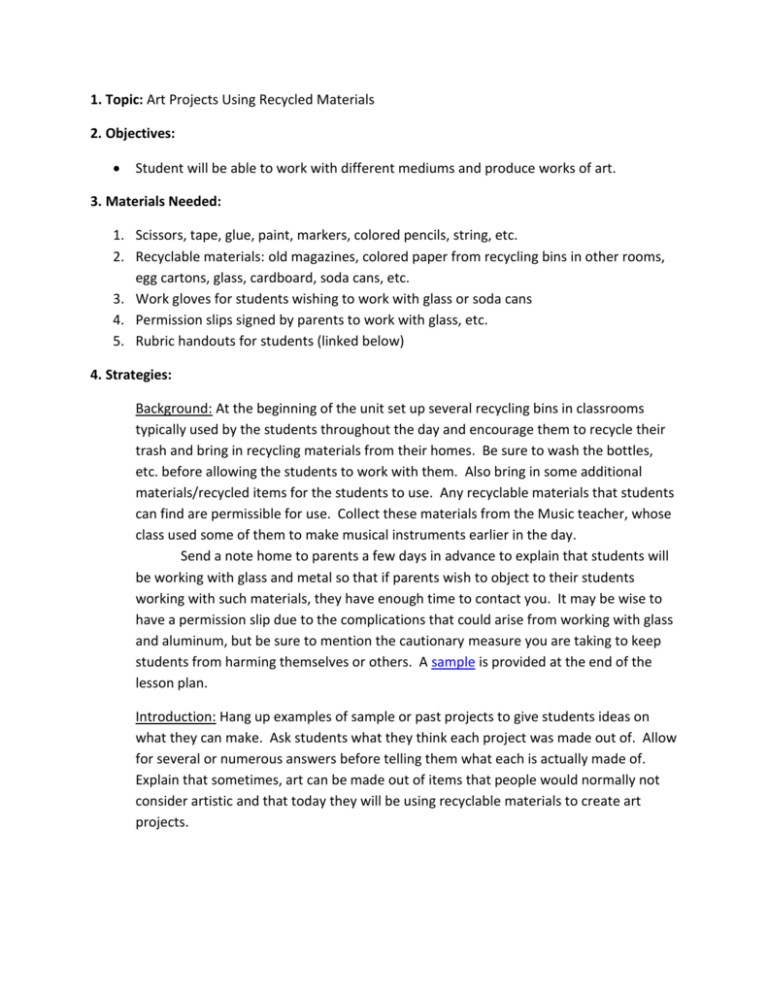
1. Topic: Art Projects Using Recycled Materials 2. Objectives: Student will be able to work with different mediums and produce works of art. 3. Materials Needed: 1. Scissors, tape, glue, paint, markers, colored pencils, string, etc. 2. Recyclable materials: old magazines, colored paper from recycling bins in other rooms, egg cartons, glass, cardboard, soda cans, etc. 3. Work gloves for students wishing to work with glass or soda cans 4. Permission slips signed by parents to work with glass, etc. 5. Rubric handouts for students (linked below) 4. Strategies: Background: At the beginning of the unit set up several recycling bins in classrooms typically used by the students throughout the day and encourage them to recycle their trash and bring in recycling materials from their homes. Be sure to wash the bottles, etc. before allowing the students to work with them. Also bring in some additional materials/recycled items for the students to use. Any recyclable materials that students can find are permissible for use. Collect these materials from the Music teacher, whose class used some of them to make musical instruments earlier in the day. Send a note home to parents a few days in advance to explain that students will be working with glass and metal so that if parents wish to object to their students working with such materials, they have enough time to contact you. It may be wise to have a permission slip due to the complications that could arise from working with glass and aluminum, but be sure to mention the cautionary measure you are taking to keep students from harming themselves or others. A sample is provided at the end of the lesson plan. Introduction: Hang up examples of sample or past projects to give students ideas on what they can make. Ask students what they think each project was made out of. Allow for several or numerous answers before telling them what each is actually made of. Explain that sometimes, art can be made out of items that people would normally not consider artistic and that today they will be using recyclable materials to create art projects. Lesson Steps: 1. Pass out the rubric for the project and explain to students that they may make any project they want, but their project must include all the requirements on the rubric. Explain to them that they will need to present their projects to the rest of the class, using the description that they write to explain their project. Write the requirements of the gallery explanation/description on the board for them and remind them to copy the necessary parts down so that if they don’t write it in class they will be able to write it at home and know what to include. The requirements are: i. Title of the work ii. Artist’s name iii. Materials used iv. Explanation of work, inspiration, or meaning 2. Give students the entire period to work, and walk around giving feedback and answering questions. 3. If there is time at the end of the period, allow students who are finished to present their projects to the class. Those who are not finished must finish their projects as homework and present them in the next class period. Lesson Closure: Have students clean up about 5 minutes before the period is over. Remind them that their projects will be displayed around the class and for parents to see on the Parents’ Night at the end of the unit. 5. Assignment: If students do not finish their art projects in class, they must finish them as their assignment and write a gallery explanation (Title of the work, artist’s name, materials used, and explanation of work, inspiration, or meaning) The project and explanation will be presented in the next class period. Extension: Student may create color-by-number pictures that have to do with recycling, or draw pictures that have to do with recycling. 6. Evaluation: Art Project (Rubric) Student Name: ____________________________________ CATEGORY 6 4 2 0 Plan/Effort Plan is creative with all necessary materials and procedures needed to create project. Student worked diligently for entire class period, or until finished. Plan is creative with most of the materials and procedures needed to create project. Student worked diligently for most of the class period. Plan provides some of the materials and procedures needed to create project. Student worked diligently for only part of the class period. Plan used only a few of the materials provided, and needed many outside materials that were not accessible. Student did not work diligently during the class period. Creativity Object is creative Object is and uses mostly somewhat recycled materials creative and most materials are recyclable. Object is a little creative and at least half of the materials are recyclable. Object is not creative and more than half of it is not recyclable. Aesthetic Aspect Project was eye catching and was artistically attractive. Project was well put together, and nice to look at. Project was well Project was poorly planned, but not constructive and not put together in an pleasing to look at. attractive manner Presentation Student was prepared, showed their project, and stated all the required aspects from their gallery description. Student was somewhat prepared, showed their project, and briefly stated the required aspects. Student was not No presentation. prepared, project was not fully done, and briefly explained some of the required aspects. Description Report does Does not include No report fully explain all information each aspect of required. the project, but each aspect is reported on. Total: ___/30 Described their project, how they came up with it, and why they chose to make it. Explained what materials they used and how they made their project. Dear Parent(s), This coming Tuesday, the art class will be making art projects out of recyclable materials. Some of these materials include aluminum cans and glass bottles. Students will be allowed to cut these cans and bottles to make their projects if they so choose. Work gloves and safety goggles be provided to students and they will be strictly supervised when using these materials. However, a permission form is provided below in order to ensure that each parent is aware that their student will be using these materials and approves of this activity. Those students whose parents do not allow them to use these materials will still take part in the activity but rather will use materials such as cardboard, paper, or plastic bottles. Thank you for your time and attention to this request. Sincerely, Miss Hoekstra ------------------------------------------------------------------------- I, _______________________ give permission that my child ____________________________ be allowed to use the glass and aluminum materials provided in art class to make art projects. Signed: _______________________________________
